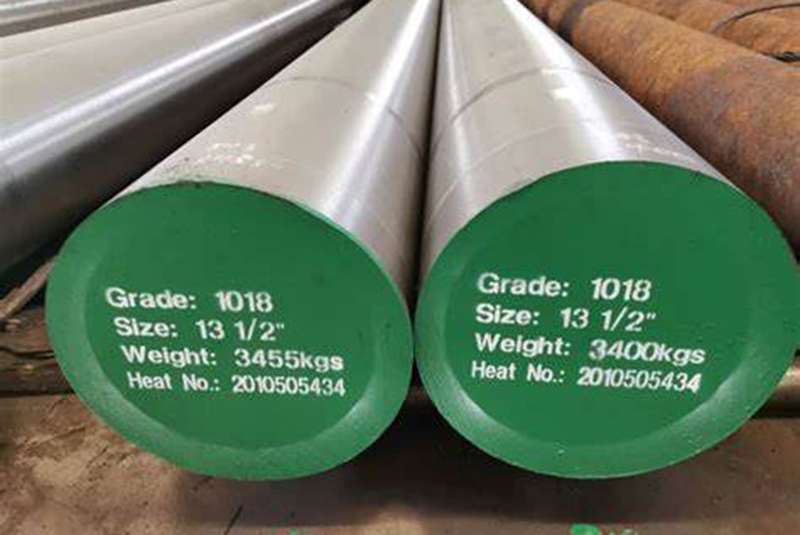Introduction

Welcome to our comprehensive guide on the physical and mechanical properties of 1018 steel. Understanding the properties of this versatile steel alloy is essential for engineers, metallurgists, and anyone involved in materials science. In this guide, we will delve into the key characteristics of 1018 steel, its applications, and how its properties make it suitable for various industries.
What is 1018 Steel?
Before delving into its properties, it’s crucial to grasp the essence of 1018 steel. Often referred to as low carbon steel, 1018 steel stands as a cornerstone in material engineering, revered for its multifaceted utility across various industries. Its nomenclature, ‘1018,’ is derived from its nominal carbon content, precisely 0.18%, a defining feature contributing to its distinct characteristics.
Renowned for its exceptional weldability, 1018 steel serves as the backbone of numerous fabrication processes, seamlessly melding with other materials to form robust structures and components. Its weldability not only simplifies assembly procedures but also ensures structural integrity, making it a preferred choice in construction, automotive, and manufacturing sectors.
Moreover, machinability emerges as another hallmark of 1018 steel, setting it apart from its counterparts. Its composition, meticulously balanced with alloying elements like manganese, phosphorus, and sulfur, facilitates effortless machining operations, allowing for intricate designs and precise dimensional accuracy. This inherent machinability not only accelerates production timelines but also minimizes tool wear, optimizing manufacturing efficiency.
Chemical Composition of 1018 Steel
To understand its properties better, let’s take a closer look at the chemical composition of 1018 steel. The table below outlines the typical composition of this alloy:
| Element | Composition (%) |
|---|---|
| Iron | 98.81 – 99.26 |
| Carbon | 0.15 – 0.20 |
| Manganese | 0.60 – 0.90 |
| Phosphorus | 0.04 (max) |
| Sulfur | 0.05 (max) |
Physical Properties
Now, let’s embark on a journey to unravel the intricate tapestry of the physical properties woven within 1018 steel. Beyond its structural prowess and mechanical resilience, 1018 steel harbors a treasure trove of characteristics that shape its behavior in the physical realm.
Density, the fundamental metric encapsulating the mass per unit volume, stands as a cornerstone in the realm of materials science. For 1018 steel, this metric manifests as a tangible representation of its compactness and molecular density, influencing its buoyancy, load-bearing capacity, and overall structural stability. Understanding the density of 1018 steel is akin to deciphering its essence, laying the groundwork for informed decision-making in diverse applications, from structural engineering to aerospace endeavors.
Thermal conductivity, the conduit through which heat traverses within a material, serves as a beacon guiding 1018 steel through the realms of temperature gradients and thermal equilibrium. As heat flows seamlessly through its molecular lattice, 1018 steel exhibits a remarkable ability to dissipate thermal energy, mitigating the risk of thermal deformation, fatigue, and catastrophic failure. This innate thermal conductivity endows 1018 steel with resilience in environments fraught with thermal fluctuations, such as industrial furnaces, automotive engines, and electrical appliances.
Electrical conductivity, the measure of a material’s ability to conduct electrical current, unveils another facet of 1018 steel’s multifaceted persona. From electrical wiring to electronic components, 1018 steel navigates the currents of electricity with finesse, facilitating the seamless flow of electrons across its crystalline structure. Its moderate electrical conductivity renders it indispensable in applications demanding electrical connectivity, grounding, and electromagnetic shielding.
Mechanical Properties
In addition to its formidable array of physical properties, 1018 steel boasts a robust suite of mechanical characteristics that fortify its stature as a stalwart in the realm of engineering materials. These mechanical properties, ranging from tensile strength and yield strength to elongation and hardness, serve as pillars supporting the structural integrity and performance of 1018 steel across diverse environments and applications.
Tensile strength, the measure of a material’s resistance to breaking under tension, stands as a testament to the intrinsic fortitude of 1018 steel. This pivotal property dictates the maximum load it can withstand before succumbing to structural failure, offering invaluable insights into its suitability for applications subjected to tensile forces, such as load-bearing structures and automotive components.
Yield strength, a critical parameter delineating the onset of plastic deformation under mechanical stress, elucidates 1018 steel’s resilience in the face of applied loads. As a material undergoes deformation, it reaches a point where its behavior transitions from elastic to plastic, signifying the onset of permanent deformation. Understanding 1018 steel’s yield strength is paramount for designing structures and components that withstand mechanical loads without compromising performance or safety.
Elongation, the measure of a material’s ability to deform plastically before fracturing, encapsulates 1018 steel’s ductility and malleability. A high elongation signifies a material’s capacity to undergo significant deformation without fracturing, rendering it conducive to forming processes such as bending, stretching, and stamping. This characteristic empowers 1018 steel to adapt to a myriad of fabrication techniques, facilitating the creation of complex geometries and intricate designs.
Applications of 1018 Steel

Given its remarkable array of properties, 1018 steel stands as a linchpin in the fabric of numerous industries, where its versatility and reliability render it indispensable. From the bustling corridors of automotive engineering to the towering edifices of construction and the intricate machinery of manufacturing, 1018 steel finds itself woven into the very fabric of modern civilization, playing a pivotal role in shaping our world.
In the automotive sector, 1018 steel emerges as a cornerstone material, underpinning the structural integrity and performance of vehicles across the globe. Its exceptional weldability and machinability make it an ideal choice for chassis components, frame rails, and structural reinforcements, where precise fabrication and assembly are paramount. Furthermore, its moderate strength and ductility imbue vehicles with resilience, absorbing impact forces and enhancing passenger safety—a testament to its enduring legacy in automotive engineering.
In the realm of construction, 1018 steel reigns supreme as a building block for innovation and durability. From skyscrapers piercing the sky to bridges spanning vast distances, its unparalleled blend of strength, ductility, and affordability makes it a preferred choice for structural elements such as beams, columns, and girders. Moreover, its ease of fabrication and adaptability to various construction techniques streamline the construction process, accelerating project timelines and minimizing costs—an invaluable asset in the dynamic landscape of modern construction.
In the realm of manufacturing, 1018 steel serves as the backbone of industrial prowess, underpinning the machinery and equipment that drive productivity and innovation. Its machinability facilitates the creation of intricate components and tooling, enabling precision manufacturing processes with minimal downtime. Whether in the fabrication of machine parts, hydraulic cylinders, or cutting tools, 1018 steel’s reliability and consistency ensure optimal performance in demanding industrial environments—a cornerstone of manufacturing excellence.
Conclusion
In conclusion, 1018 steel offers a unique combination of properties that make it a valuable material in numerous industries. Its affordability, machinability, and weldability, coupled with decent strength and hardness, render it indispensable for many applications. Understanding its physical and mechanical properties is crucial for optimizing its use in various engineering and manufacturing endeavors.
FAQs
What are the key properties of 1018 steel?
The key properties of 1018 steel include its low carbon content, good weldability, machinability, and moderate strength.
What are the typical applications of 1018 steel?
1018 steel is commonly used in automotive components, construction materials, machinery parts, and shafts due to its versatility and cost-effectiveness.
How does 1018 steel compare to other steel alloys?
Compared to higher carbon steels, 1018 steel offers better weldability and machinability but lower strength and hardness. It is often preferred for applications that prioritize ease of fabrication and cost efficiency.
